Native Instruments REAKTOR SPARK User manual
- Type
- User manual

OPERATION MANUAL

The information in this document is subject to change without notice and does not represent a
commitment on the part of Native Instruments GmbH. The software described by this document is
subject to a License Agreement and may not be copied to other media. No part of this publication
may be copied, reproduced or otherwise transmitted or recorded, for any purpose, without prior
written permission by Native Instruments GmbH, hereinafter referred to as Native Instruments. All
product and company names are ™ or ® trademarks of their respective owners.
KORE SOUND is a ® trademark of NATIVE INSTRUMENTS.
Users Guide written by Aleksander Rebane
Document version: 1.0.1 (12/2008)
Software version: 1.0.1
Special thanks to the Beta Test Team, who were invaluable not just in tracking down bugs, but in
making this a better product.

Germany
NATIVE INSTRUMENTS GmbH
Schlesische Str. 28
D-10997 Berlin
Germany
info@native-instruments.de
www.native-instruments.de
USA
NATIVE INSTRUMENTS North America, Inc.
5631 Hollywood Boulevard
Los Angeles, CA 90028
USA
sales@native-instruments.com
www.native-instruments.com
MASSIVE was designed and developed entirely by Native Instruments GmbH. Solely the name
Massive is a registered trademark of Massive Audio Inc, USA.
© Native Instruments GmbH, 2008. All rights reserved.

GETTING STARTED – 4
1. Welcome to REAKTOR SPARK!
Thank you very much for purchasing REAKTOR SPARK. On behalf of the entire NATIVE
INSTRUMENTS team, we hope that this KORE SOUNDPACK will truly inspire you.
REAKTOR SPARK contains 200 new KORE SOUNDS
®
, based on a newly designed
REAKTOR ensemble. These sounds have been designed to integrate seamlessly into your
KORE SOUND database, making them easily accessible. Also, like the
KORE 2
/
KORE
PLAYER factory content, all KORE SOUNDPACKS utilize the KORE 2/KORE PLAYER’s
Integrated Engines: You only need KORE 2 or KORE PLAYER to make full use of their
sonic capabilities. Furthermore, the sounds have been equipped with dedicated Control
3DJHDVVLJQPHQWVSXWWLQJWKHPRVWLPSRUWDQWPXVLFDOSDUDPHWHUVULJKWDW\RXUƂQJHUWLSV
Individual Sound Variations have been created for each KORE SOUND of this product,
DGGLQJWRWKHQXPEHURISUHFRQƂJXUHGVRXQGV
This manual will help you get started with your KORE SOUNDPACK. If you want to start
immediately, proceed to the Installation and Activation section. Please read that chapter
carefully and fully, as it explains all the steps required to integrate the KORE SOUNDPACK
into
KORE 2
/
KORE PLAYER
. Following the Installation chapter is an explanation of how
to use the KORE SOUNDS within KORE 2/KORE PLAYER. If you are already familiar with
KORE 2
/
KORE PLAYER
, this will be straightforward, but it might be worth a look nonethe-
less. Finally, the last section of this manual adds some more details regarding the sounds
that come with REAKTOR SPARK.

GETTING STARTED – 5
2. What is REAKTOR SPARK?
REAKTOR SPARK puts a large collection of production-ready sounds for contemporaryputs a large collection of production-ready sounds for contemporary
PXVLFSURGXFWLRQGLUHFWO\XQGHU\RXUƂQJHUWLSVREAKTOR SPARK has it all, from pad to
OHDGVRXQGVIURPSHUFXVVLYHNH\ERDUGVWRƃRDWLQJVRXQGVFDSHV7KHYDULHW\EHFRPHV
SRVVLEOHGXHWRWKHVSHFLƂFDOO\GHVLJQHGREAKTOR ensemble SPARK, whose internal
feedback structure gives the characteristic sonic touch to the Soundpack.
When loading a KORE SOUND from this collection,
KORE 2
/
KORE PLAYER
automatically
ORDGVLWV,QWHJUDWHG(QJLQHVDQGDGMXVWVWKHVSHFLƂFVRXQG7KLVDOOKDSSHQVDXWRPDWLFDOO\
with no additional adjustments necessary.
After loading the sound, you are ready to tweak it. The Control Pages and Sound Variations,
preassigned for each KORE SOUND, enable you to adjust each sound to your production
needs or simply morph from one sound world to another.

GETTING STARTED – 6
3. Installation and Activation
The following section explains how to install and activate REAKTOR SPARK. Although this
process is straightforward, please take a minute to read these instructions, as doing so
might prevent some common problems.
3.1 Installing REAKTOR SPARK
After downloading the KORE SOUNDPACK, unzip the compressed archive you received
IURP1$7,9(,167580(176,WFRQWDLQVWKLVGRFXPHQWDWLRQDVD3')ƂOHDVZHOODVDQ
installer application.
To install REAKTOR SPARK, double-click the installer application and follow the instruc-
tions on the screen. The installer application automatically places the new KORE SOUND
FRQWHQWƂOHVLQWRWKHIROGHUVWKDW KORE 2/KORE PLAYER expects them to be in. In the
course of the installation procedure, the installer application will ask you to specify another
IROGHUIRUDGGLWLRQDOƂOHVOLNHWKLVPDQXDO
All sounds coming with REAKTOR SPARK can be used directly within KORE 2 or KORE
PLAYER,
which use the Integrated Engines to actually load and play the sounds. If you
own REAKTOR, you can also load the SPARK ensemble directly into Reaktor.

GETTING STARTED – 7
3.2 Activating REAKTOR SPARK
:KHQLQVWDOODWLRQLVƂQLVKHGVWDUWWKH
SERVICE CENTER
that was installed with
KORE
2/KORE PLAYER. It will connect your computer to the Internet and activate your REAKTOR
SPARK installation. In order to activate your copy of REAKTOR SPARK, you have to perform
the following steps within the SERVICE CENTER:
Log in: Enter your
NATIVE INSTRUMENTS
user account name and password on the
initial page. This is the same account information you used in the NATIVE INSTRUMENTS
Online Shop, where you bought your KORE SOUNDPACK, and for other NATIVE
INSTRUMENTS product activations.
Select products: The Service Center detects all products that have not yet been acti-
vated and lists them. You can activate multiple products at once — for example, KORE
2/KORE PLAYER and your KORE SOUNDPACK, or several KORE SOUNDPACKS.
Activate: After proceeding to the next page, the Service Center connects to the NATIVE
INSTRUMENTS server and activates your products.
'RZQORDGXSGDWHV:KHQWKHVHUYHUKDVFRQƂUPHGWKHDFWLYDWLRQWKH6HUYLFH&HQWHU
automatically displays the Update Manager with a list of all available updates for your
installed products. Please make sure that you always use the latest version of your
NATIVE INSTRUMENTS products to ensure proper functioning.
Now, you are ready to use REAKTOR SPARK. Please start KORE 2/KORE PLAYER in the
standalone mode. This will trigger the database update process automatically and integrate
the new KORE SOUNDS into KORE 2/KORE PLAYER’s database. The next chapter will
explain how to use the new sounds in KORE 2/KORE PLAYER.
1.
2.
3.
4.
A c t i v a t i o n o f K O R E
SOUNDPACKS is optional.
However, it will give you access to free
updates.
A c t i v a t i o n o f K O R E
SOUNDPACKS is optional.
However, it will give you access to free
updates.
Downloading updates is option-
al. After activation is complete,
you can always quit the Service Center.
Downloading updates is option-
al. After activation is complete,
you can always quit the Service Center.

GETTING STARTED – 8
4. How to use REAKTOR SPARK
The following sections will give you a brief overview over some basic operations: you will
learn how to search for sounds you have in mind and how to load and play KORE SOUNDS.
For details about these topics please read the KORE 2/KORE PLAYER manual.
4.1 Finding a KORE SOUND
All REAKTOR SPARK KORE SOUNDS are directly integrated into KORE 2’s/KORE PLAYER’s
database. They will show up in the Browser’s Search Results List alongside all the other
VRXQGVWKDWPDWFK\RXUVSHFLƂFVHDUFKFULWHULDŏIRUH[DPSOHDFRPELQDWLRQRI$WWULEXWHV
7RUHVWULFW\RXUVHDUFKUHVXOWVWR\RXUVSHFLƂFSDFNőVVRXQGVVHOHFWWKHGHVLUHGSDFNLQ
the SOUNDPACK column of the Attributes List. The Search Results List shows the entire
content of this particular pack.
7KHUHLVDQRWKHUZD\WRUHVWULFW\RXUVHDUFKUHVXOWVWR\RXUVSHFLƂFSDFNőVVRXQGVVLPSO\
enter the KORE SOUNDPACK’s name into the QUICK SEARCH FIELD of the Browser, or even
just a part of the name — for example, “spark”. The corresponding KORE SOUNDS au-
tomatically appear in the Search Results List.
If you don’t want to limit the results to this KORE SOUNDPACK, but do want to have the
display grouped by SOUNDPACKS, you can show the bank name within the Search Results
List and sort the list according to this entry. To do so, right-click the Search Results List’s
header row and activate the Bank entry in the upcoming context menu. This will show
each KORE SOUND’s bank name in a new column of the Search Results List. Now click
WKH%DQNFROXPQőVKHDGHUWRVRUWWKHOLVWDFFRUGLQJWRWKLVVSHFLƂFDWLRQ7KLVZLOOJURXS
the results.
KORE 2 users: if the Soundpack
column is not visible in the
Attributes List, right-click on the
Attributes List header and select the
Soundpack entry in the upcoming con-
text menu.
KORE 2 users: if the Soundpack
column is not visible in the
Attributes List, right-click on the
Attributes List header and select the
Soundpack entry in the upcoming con-
text menu.

GETTING STARTED – 9
4.2 Loading the KORE SOUND
4.2.1 Loading the KORE SOUND in KORE PLAYER
After you have located your KORE SOUND, load it by double-clicking its Search Results
List entry. Alternatively, drag it onto KORE PLAYER’s Global Controller. Both actions replace
WKHFXUUHQWO\ORDGHG.25(6281'ŏLILWLVWKHƂUVW.25(6281'\RXDUHORDGLQJDIWHU
start-up, it will replace an “empty” KORE SOUND.
When loaded, the KORE SOUND will automatically be displayed so that its Control Pages
are directly mapped onto the Global Controller. For each KORE SOUND, a User Page has
been pre-assigned, granting direct access to the KORE SOUND’s most important param-
HWHUV7KHH[DFWEXWWRQVDQGNQREVDVVLJQPHQWVRQWKH&RQWURO3DJHDUHVSHFLƂFWRHDFK
KORE SOUND, as well as the number of Control Pages. With the Global Controller, you
also have immediate control of the KORE SOUND’s Sound Variations. Please refer to the
KORE PLAYER manual for details about Control Pages and Sound Variations.
If you are using
KORE PLAYER
as a plug-in in a host environment, you can save the posi-
tions/states that you set on the eight knobs and eight buttons of the Control Page: sav-
ing the host’s project saves all settings of all incorporated plug-ins (among others, KORE
PLAYER) and thus all changes you made to the loaded KORE SOUND.
4.2.2 Loading the KORE SOUND in KORE 2
After you have located your KORE SOUND, load it by double-clicking its Search Results
List entry. Alternatively, drag it onto KORE 2’s Global Controller. Both actions will replace
WKHFXUUHQWO\IRFXVHG.25(6281'ŏLILWLVWKHƂUVW.25(6281'\RXORDGDIWHUVWDUW
up, it will replace an “empty” KORE SOUND. If you want to place the KORE SOUND into
DVSHFLƂF&KDQQHO,QVHUWZLWKLQWKH(GLW$UHDLQVWHDGRIORDGLQJWKH.25(6281'LQWR
the focused one), you can also drag it directly into the Sound Matrix.
7KHH[DFWEXWWRQVDQGNQREVDVVLJQPHQWVRQWKH8VHU3DJHDUHVSHFLƂFWRHDFK.25(
SOUND. With the Global Controller, you also have immediate control of the KORE SOUND’s
Sound Variations. Please refer to the
KORE 2
/
KORE PLAYER
manual for details about Control
Pages and Sound Variations.

GETTING STARTED – 10
If you have the full version of the Integrated Engine installed, you can also open the engine
itself. Just click the PLUG-IN EDITOR ICON within the Global Controller, or double-click the
Channel Insert within the Sound Matrix. This will give you full access to all parameters of
the KORE SOUND, exceeding the options in KORE 2’s Control Pages. Note that this will
change the status of the KORE SOUND: After you have opened a KORE SOUND using
its associated plug-in editor, it will always require the respective plug-in’s fully licensed
version to be installed. (Of course, opening the KORE SOUND in the plug-in’s full version
GRHVQRWDOWHUWKHRULJLQDO.25(6281'ƂOHEXWFUHDWHVDFRS\WKDW\RXPLJKWZDQWWR
VDYHDVDVHSDUDWHƂOHODWHU,I\RXGRQRWXVHWKHIXOOHGLWRUIRUHGLWLQJD.25(6281'
but instead only use the Control Pages and the Sound Variations, the KORE SOUND will
again be loadable without the full license available.
After you have tweaked the KORE SOUND to your liking, you can save it to the User Sounds
content by dragging it back onto the Search Results List — just the opposite of the loading
process. Within the Save List, you can edit the KORE SOUND’s name, enter your name as
WKH.25(6281'őVDXWKRUDQGVRRQ:KHQƂQLVKHGFOLFNWKHDONE BUTTON to save the
KORE SOUND to the database. It is now available for each project you are working on.
Alternatively, the KORE SOUND and all changes you made are also saved when you store
the Performance of KORE 2. However, the KORE SOUND is not automatically added to
the Browser’s database. The same happens if you are using KORE 2 as a plug-in: saving
the host’s project saves all settings of all incorporated plug-ins (like KORE 2) and thus all
changes you made to the loaded KORE SOUND.
If these terms are completely
new to you, chapter 3.1 of
the KORE 2 manual provides general
information, and chapter 3.1.4 covers
the Control Page system and Sound
Variations.
If these terms are completely
new to you, chapter 3.1 of
the KORE 2 manual provides general
information, and chapter 3.1.4 covers
the Control Page system and Sound
Variations.

GETTING STARTED – 11
5. Content Description
7KHIROORZLQJSDUDJUDSKVEULHƃ\GHVFULEHWKHREAKTOR SPARK content. However, listening
to the KORE SOUNDS tells much more than mere words. These descriptions will give you a
starting point, but you’ll probably learn most about this KORE SOUNDPACK by using it!
The
REAKTOR SPARK
provides you with a diverse collection of dynamic and expressiveprovides you with a diverse collection of dynamic and expressive
sounds based on the new and innovative SPARK ensemble. These sounds can range from
saucy synth leads to vibrant percussive sounds or play the role of quasi-chaotically evolvingchaoticallyevolving evolving
pads, but all of them have one thing in common: they readily respond to your individual
way of playing. In either a studio environment or a live performance situation, the soundsIn either a studio environment or a live performance situation, the sounds
included in the REAKTOR SPARK can be used in Rock, Jazz, Industrial, Psychedelic, Sound
Tracks, and various electronic genres ranging from Electro to IDM… But the musical genre
is actually not important: It’s all up to you!
The following sections describe how you can use these sounds in KORE or KORE PLAYER.
If you also own REAKTOR, you can access SPARK’s control panel as well. The details
about using SPARK are given within the “Using SPARK in
REAKTOR
” and “SPARK Control
Reference” sections below.

GETTING STARTED – 12
5.1 The SPARK Ensemble
The SPARK Ensemble in REAKTOR
SPARK takes full advantage of the far-reaching capabilities oftakes full advantage of the far-reaching capabilities of REAKTOR to generate dy-
namic, expressive, organic and dirty sounds. The main concept behind SPARK is to allow
GUDPDWLFUHDOWLPHLQƃXHQFHRQWKHVRXQGVRXUFH/LNHDQDWXUDOLQVWUXPHQWLWQHHGVWR
be played expressively in order to reach its full potential. SPARK’s secret lies in the way
LWXVHVYDULRXVIHHGEDFNORRSVWRJHQHUDWHLWVRZQLQSXWHQDEOLQJ\RXWRLQƃXHQFHWKH
sound with relatively few, but carefully chosen parameters.

GETTING STARTED – 13
5.2 Using SPARK in KORE or KORE PLAYER
Allll REAKTOR SPARK sounds share the same control interface within KORE 2’s or KORE
PLAYER
’s Global Controller: the SPARK Synth Essentials Page, the SPARK Mix & FX
Essentials Page, the SPARK More Synth & FX Page, and the SPARK Macro Controls &
LFO Page.
5.2.1 SPARK Synth Essentials Page
The SPARK Synth Essentials Page provides access to the SPARK Ensemble’s most important parameters.
OSC MIX: TheThe OSC MIX KNOB determines the main characteristic of the sound source. It
acts as a crossfader between the Pulse and Sine Oscillators for the mixed output sig-
nal. Turning O
SC
M
IX
to the right crossfades to the Sine signal, turning it to the left
crossfades to the Pulse signal.
L-B-H: Depending on the setting of the L-B-H KNOBRQHFDQPL[EHWZHHQƂOWHULQJRXW
different frequencies in relation to the cutoff frequency (determined by the CUTOFF
KNOB). Turning the L-B-H KNOB to the left lets frequencies below the cutoff frequency
pass, with the vertical setting of the knob causes frequencies within a certain distance
from the cutoff frequency pass, and with the knob turned to the right, frequencies
above the cutoff frequency are allowed to pass.
CUTOFF6HWVWKHFXWRIIIUHTXHQF\RIWKHƂOWHUPL[GHWHUPLQHGE\WKHL-B-H KNOB.
RESO: Sets the enhancement of the frequencies around the cutoff frequency set with
the CUTOFF KNOB.
FEEDBACK: Turning thehe FEEDBACK KNOB only slightly can already change the sound very
drastically. The result can be self-oscillating sounds with a pitch that is only dependent
Ź
Ź
Ź
Ź
Ź

GETTING STARTED – 14
on the cutoff frequency (determined by the C
UTOFF
K
NOB
), or sounds resembling acous-
tic feedbacks of microphones, speakers, or guitar amps.
2ND H: Lets you change the harmonic content of the signal by wave-shaping. At zero
the shaping curves are symmetric, creating mainly odd harmonics. With larger values
the curve gets increasingly asymmetric and the amount of the 2nd and other even
harmonics is increased.
TIME: The TIME KNOBVHWVWKHGHOD\WLPHRIWKHYRLFHGHOD\,WKDVDELJLQƃXHQFHRQ
which frequencies will be excited in the feedback path by the application of a delay.
You can use the delay also in the signal that is routed to the Effects section, just mix
it with the other output signals by using the DEL + F KNOB in the SPARK Mix & FX
Essentials Page to get a coloring or chorusing effect.
FREQ SH: All frequencies entering the frequency shifter are shifted by the value set by
the FREQ SH KNOB. This usually results in an inharmonic or phasing sound.
FS MIX: The effect of the frequency shifter controlled by the FREQ SH KNOB can be
turned on and off with the FS MIX BUTTON.
SYNC: This controls the hard synchronization of the Pulse oscillator to the feedback
signal.
5.2.2 SPARK Mix & FX Essentials Page
The SPARK Mix & FX Essentials Page holds a set of effects and mix controls.
SINE: Determines the amount of the Sine Oscillator signal that gets mixed into the ef-Determines the amount of the Sine Oscillator signal that getsmixedintotheef- mixed into the ef-
fects chain input. This signal is modulated by the oscillator amplitude envelope.
Ź
Ź
Ź
Ź
Ź
Ź
7KHƂUVWƂYHNQREVRIWKH6SDUN
Mix & Essentials Page control-
ling mixer can vary between different
REAKTOR SPARK KORE SOUNDS. The
GHƂQLWLRQVJLYHQKHUHDUHIRUSDUDPHWHUV
that are frequently assigned to these
knobs.
7KHƂUVWƂYHNQREVRIWKH6SDUN
Mix & Essentials Page control-
ling mixer can vary between different
REAKTOR SPARK KORE SOUNDS. The
GHƂQLWLRQVJLYHQKHUHDUHIRUSDUDPHWHUV
that are frequently assigned to these
knobs.

GETTING STARTED – 15
LP4:'HWHUPLQHVWKHDPRXQWRIVLJQDOIURPWKHSROHORZSDVVƂOWHUWKDWJHWVPL[HG
LQWRWKHHIIHFWVFKDLQLQSXW7KHFXWRIIIUHTXHQF\RIWKLVƂOWHULVGHWHUPLQHGE\WKH
CUTOFF KNOB in the SPARK Synth Essentials Page.
BP2'HWHUPLQHVWKHDPRXQWRIVLJQDOIURPWKHSROHEDQGSDVVƂOWHUWKDWJHWVPL[HG
into the effects chain input. In case there is a HP2 Knob instead, it determines the
DPRXQWRIVLJQDOIURPWKHSROHKLJKSDVVƂOWHUWKDWJHWVPL[HGLQWRWKHHIIHFWVFKDLQ
LQSXW7KHFXWRIIIUHTXHQF\RIWKLVƂOWHULVGHWHUPLQHGE\WKHCUTOFF KNOB in the
SPARK Synth Essentials Page.
S
HAPER
: Determines the amount of signal from the wave-shaper that gets mixed into
the effects chain input. Use this to add the higher harmonics created in the wave-
shaper to the mix.
REVERB: Acts as a crossfader between the wet and dry signal of the reverb unit in the
effects chain.
DELAY: Acts as a crossfader between the wet and dry signal of the Mod Delay unit in
the effects chain.
TIME: Use this knob to set the delay time in the Modulation Delay unit in the effects
chain.
S
YNC
: Activate the S
YNC
B
UTTON
to synchronize the delay time of the Modu Delay unit
WRWKHWHPSRVSHFLƂHGE\KORE or KORE PLAYER.
DEL+F: Determines the amount of signal from the frequency shifter effect that gets
mixed into the effects section.
5.2.3 SPARK More Synth & FX Page
7KH63$5.0RUH6\QWK);3DJHKROGVFRQWUROVWKDWOHW\RXƂQHWXQH\RXUV\QWKDQGHIIHFWVVHWWLQJV
Ź
Ź
Ź
Ź
Ź
Ź
Ź
Ź

GETTING STARTED – 16
ATT: Controls the time the amplitude envelope of the Sine and Pulse oscillators takes
to reach the peak value after the key is pressed. Higher values yield higher times.
REL: Controls the time the amplitude envelope of the Sine and Pulse oscillators takes
to reach zero after the key is released. Higher values yield higher times.
PW: The PW Knob determines the static Pulse width amount of the Pulse oscillator.
When the knob is in the vertical position, the Pulse oscillator only creates odd harmon-
ics. Odd harmonics create a sound that is, for example, typical for a clarinet. Turning
the PW K
NOB
either to the left or to the right creates even harmonics, yielding a more
“buzzy” sound.
CAB CUT: The more you turn this knob to the left, the more you remove the higher
frequencies created by the saturator in the Cabinet effect in the effects chain. The
CAB CUT KNOBVHWVWKHFXWRIIIUHTXHQF\RIWKHORZSDVVƂOWHUWKDWLVSODFHGEHIRUHWKH
output of the Cabinet saturator effect.
8-P
OLE
: This knob acts as a crossfader between the wet and dry signal of the stereo
8-pole Filter in the effects chain.
CENTER: Sets the mean cutoff frequency of the 8-pole Filter in the effects chain.
CABINET: Acts as a crossfader between the wet and dry signal of the Cabinet saturator
in the effects chain.
CAB TILT: This parameter determines which frequencies get distorted by the cabinet
saturator effect: turn the TILT KNOB to the right for distortion at lower frequencies and
to the left for distortion at higher frequencies.
5.2.4 SPARK Macro Controls & LFO Page
The SPARK Macro Controls and LFO Page holds macro controls that let you tweak two parameters at once.
Ź
Ź
Ź
Ź
Ź
Ź
Ź
Ź

GETTING STARTED – 17
MC 1: This knob controls the macro controller 1. Two parameters which are frequent-
ly assigned to this controller are the amplitude of the oscillators and the input gain
(drive) of the wave-shaper unit.
MC 2: This knob controls the macro controller 2. Two parameters which are frequently
DVVLJQHGWRWKLVFRQWUROOHUDUHWKHFXWRIIIUHTXHQF\DQGUHVRQDQFHRIWKHLQWHUQDOƂOWHU
MC 3: This knob controls the macro controller 3. Two parameters which are frequent-
ly assigned to this controller are the amount of signal feedback to the input of the
Ringmod/Filters section and the dry/wet mix of the cabinet saturator unit.
VELOCITY: When the LF VEL BUTTON is activated, this knob sets the center value around
which the LFO modulates the velocity parameter of the instrument.
LFO RATE: The macro controllers can be controlled by an LFO if the LFM BUTTON (see
below) is turned on for that particular controller. The LFO RATE KNOB sets the fre-
quency of the LFO.
PHASE: Determines the phase of the LFO. Read about the T SYNC and K SYNC Parameters
below for more information on the effect of the PHASE KNOB.
CLIP: Sets the amount of clipping to the LFO signal.
AMOUNT: Determines the amplitude of the LFO and with it the amount of modulation
to the macro controller parameters.
LFM1: If activated, the macro controller 1 parameter is modulated by the LFO.
LFM2: If activated, the macro controller 2 parameter is modulated by the LFO.
LFM3: If activated, the macro controller 3 parameter is modulated by the LFO.
LF V
EL
: The velocity events received from the keyboard or sequencer are overridden if the
LF VEL BUTTON is on and replaced by the LFO modulated value set by the VELOCITY KNOB.
T SYNC: If activated, the LFO is synchronized to the global tempo assigned determined
by KORE. If the T SYNC BUTTON is activated and the K SYNC BUTTON deactivated, the
LFO phase is also synchronized with the song position. The phase of the LFO at the
beginning of the song is set by the PHASE KNOB.
K SYNC: With K SYNC activated, the LFO is restarted every time a note is played. The
phase at which the LFO restarts is set by the PHASE KNOB.
Ź
Ź
Ź
Ź
Ź
Ź
Ź
Ź
Ź
Ź
Ź
Ź
Ź
Ź
The particular effect of the macro
controllers differs between KORE
SOUNDS, as the instrument parameters
which they have been assigned to were
carefully chosen by the sound designer to
suit the particular KORE SOUND.
The particular effect of the macro
controllers differs between KORE
SOUNDS, as the instrument parameters
which they have been assigned to were
carefully chosen by the sound designer to
suit the particular KORE SOUND.

GETTING STARTED – 18
CLIP SYM: With CLIP SYM deactivated, only the bottom half of the LFO waveform is
clipped. With the Clip Sym activated, only the top part of the LFO waveform is clipped.
The amount of clipping is determined by the CLIP KNOB.
T
RI
S
YM
: If deactivated, the LFO waveform is a symmetric triangle. With the T
RI
S
YM
activated, the LFO waveform becomes a falling sawtooth.
5.3 Using SPARK in REAKTOR
In this section we will discuss how to make the best use of SPARK’s control panel within
REAKTOR
. It is exactly because of SPARK’s unconventional signal routing that SPARK
achieves its expressive sonic character. Not only SPARK’s sonic capabilities set it apart
from other more conventional synthesizers, but also the way it is used. To help you get fa-
PLOLDUZLWKWKHEHKDYLRXURI63$5.őVFRQWUROVZHZLOOEULHƃ\GLVFXVVWKHVLJQDOƃRZZLWKLQ
the ensemble and then proceed to demonstrate the most prominent aspects of SPARK
in a step-by-step tutorial.
5.3.1 Signal Flow
SPARK’s control panel features the access to parameters that cannot be intuitively under-
VWRRGZLWKRXWNQRZOHGJHRIWKHVLJQDOƃRZ$FFRUGLQJWRWKHƂJXUHRQWKHIROORZLQJSDJH
ZHZLOOJRWKURXJKWKHPDLQDVSHFWVRI63$5.őVVLJQDOƃRZ7KHQDPHVRIWKHGLIIHUHQW
SDUWVRIWKHVLJQDOƃRZWKDWGLUHFWO\FRUUHVSRQGWRWKHODEHOVLQWKHFRQWUROSDQHODUHFDSL-
talized and given the name sections.
The sound generation in the instrument happens by two oscillators, Pulse and Sine, in
the Oscillators section. Here we see how the output of two simple oscillators is more than
just simple static waveforms: SPARK’s signal routing makes it possible to create complex
and evolving waveforms by letting the feedback signal control both oscillators by frequency
PRGXODWLRQDQGRUWKH3XOVHRVFLOODWRUE\KDUGV\QFKURQL]DWLRQ,QWKHƂJXUHRQWKHQH[W
page, the bold lines illustrate the path of the feedback signal.
Ź
Ź

GETTING STARTED – 19
7KLVGLDJUDPVKRZV63$5.őVIHHGEDFNVLJQDOƃRZ

GETTING STARTED – 20
The output of the Oscillators section is the mixed with the feedback signal by the crossfader
PDUNHGDVœ)LOWHU)%ŔDQGIHGDVWKHFDUULHUVLJQDOWRDQDPSOLWXGHPRGXODWRUWKHƂUVW
element in the Ringmod/Filters section. Again, the modulating signal again is the feedback
signal. Amplitude modulation reduces the presence of the carrier signal harmonics, but
adds the harmonics of the modulation signal into the mix in a more complex manner than
just adding the two signals together.
The amplitude modulated signal is then ring modulated by the output of the Oscillators
section. Ring modulation causes the harmonics to be mixed in a manner similar to am-
plitude modulation with the difference that the harmonics of the incoming signals are not
left intact. This often causes inharmonic spectra. The signal from the ring modulator is
WKHQIHGWRWKHƂOWHUDQGVXEVHTXHQWO\WRWKHVKDSHU
The voice delay in the Special section is a key element in the creating the feedback signal,
it determines which frequencies are excited in the feedback loop. The frequency shifter is
the last structure that allows direct manipulation of the frequency content of the spectra.
In the Mixer section, the signals from different points along the described path can be
tapped and mixed together to be processed by the Effects section. The effects are always
running and the degree that the output of the Mixer section is processed by a certain ef-
fect unit is controlled by the unit´s MIX KNOB.
The feedback signal is put together in the SPECIAL SECTION using the “FB Mono” and “Int
– Ext” crossfaders, where turning the knobs to the right increasingly crossfades to the sig-
QDOWKDWLVUHSUHVHQWHGRQWKHULJKWVLGHRIWKHFURVVIDGHULQWKHƂJXUH%\QRZLWLVIDLUO\
obvious that the sound that reaches the instrument output at the end of the effects chain
can have a wide range of timbres and evolving behaviours made possible by manipulating
WKHIHHGEDFNORRS(YHQZLWKJRRGNQRZOHGJHRIWKHVLJQDOƃRZWKHHIIHFWVRIFKDQJLQJ
the parameters can often be quite surprising, but that is also part of the fun when explor-
ing SPARK’s capabilities.
Page is loading ...
Page is loading ...
Page is loading ...
Page is loading ...
Page is loading ...
Page is loading ...
Page is loading ...
Page is loading ...
Page is loading ...
Page is loading ...
Page is loading ...
Page is loading ...
Page is loading ...
Page is loading ...
Page is loading ...
Page is loading ...
Page is loading ...
Page is loading ...
Page is loading ...
Page is loading ...
Page is loading ...
Page is loading ...
Page is loading ...
Page is loading ...
Page is loading ...
Page is loading ...
Page is loading ...
Page is loading ...
-
 1
1
-
 2
2
-
 3
3
-
 4
4
-
 5
5
-
 6
6
-
 7
7
-
 8
8
-
 9
9
-
 10
10
-
 11
11
-
 12
12
-
 13
13
-
 14
14
-
 15
15
-
 16
16
-
 17
17
-
 18
18
-
 19
19
-
 20
20
-
 21
21
-
 22
22
-
 23
23
-
 24
24
-
 25
25
-
 26
26
-
 27
27
-
 28
28
-
 29
29
-
 30
30
-
 31
31
-
 32
32
-
 33
33
-
 34
34
-
 35
35
-
 36
36
-
 37
37
-
 38
38
-
 39
39
-
 40
40
-
 41
41
-
 42
42
-
 43
43
-
 44
44
-
 45
45
-
 46
46
-
 47
47
-
 48
48
Native Instruments REAKTOR SPARK User manual
- Type
- User manual
Ask a question and I''ll find the answer in the document
Finding information in a document is now easier with AI
Related papers
-
 Native Instruments REAKTOR SPARK Owner's manual
Native Instruments REAKTOR SPARK Owner's manual
-
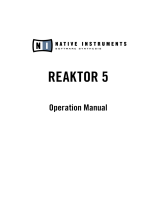 Native Instruments Reaktor 5 User guide
Native Instruments Reaktor 5 User guide
-
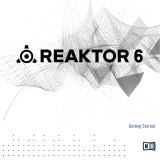 Native Instruments REAKTOR 6 Quick start guide
Native Instruments REAKTOR 6 Quick start guide
-
 Native Instruments Reaktor 5 Quick start guide
Native Instruments Reaktor 5 Quick start guide
-
 Native Instruments Massive 1.5.5 User manual
Native Instruments Massive 1.5.5 User manual
-
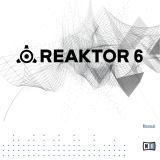 Native Instruments REAKTOR FACTORY LIBRARY Owner's manual
Native Instruments REAKTOR FACTORY LIBRARY Owner's manual
-
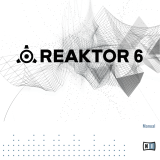 Native Instruments REAKTOR 6 User manual
Native Instruments REAKTOR 6 User manual
-
 Native Instruments Super 8 Owner's manual
Native Instruments Super 8 Owner's manual
-
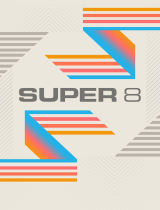 Native Instruments Super 8 Owner's manual
Native Instruments Super 8 Owner's manual
-
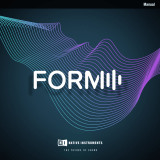 Native Instruments FORM Owner's manual
Native Instruments FORM Owner's manual
Other documents
-
KOREHEALTH Kore 2.0 User guide
-
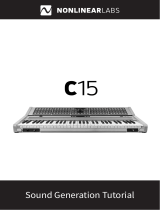 NONLINEAR LABS C15 Tutorial
NONLINEAR LABS C15 Tutorial
-
Steinberg Retrologue User manual
-
 Tacens MC3 Datasheet
Tacens MC3 Datasheet
-
Tascam GVI User manual
-
KOREHEALTH 30538 User manual
-
 Sun Mountain Micro Cart User manual
Sun Mountain Micro Cart User manual
-
Radial Engineering MC3 Owner's manual
-
Radial Engineering MC3 Owner's manual
-
DOEPFER A-116 VC Waveform Processor User manual




























































